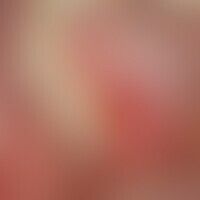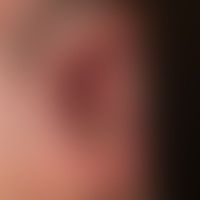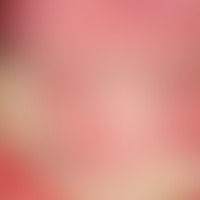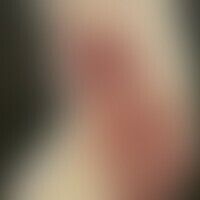Image diagnoses for "Skin defects (superficially, deep)", "red"
155 results with 384 images
Results forSkin defects (superficially, deep)red

Angiosarcoma epitheloides C44.-

Fixed drug eruption L27.1
Drug reaction, fixed: multilocular fixed drug reaction with extensive epidermolysis on sharply defined erosions in the area of the back of the hand and thumb.

Bullous Pemphigoid L12.0
Pemphigoid, bullous. detail enlargement: Chronically active, intermittent, enoral, laminar erosions in a 36-year-old woman.

Pemphigus vulgaris L10.0
Pemphigus vulgaris: chronically persistent, extensive, painful erosions in previously known pemphigus vulgaris.

Basal cell carcinoma destructive C44.L
Basal cell carcinoma, destructive: large-area, sharply defined, deep ulcer with sharply defined, raised rim.

Pemphigus vulgaris L10.0
Pemphigus vulgaris: chronically persistent, extensive, painful erosions of the cheek mucous membrane and lips.

Venous leg ulcer I83.0

Anal dermatitis (overview) L30.8
eczema, anal eczema. uniform, perianal localized, partly erosive-wetting, blurred, smooth redness. severe, persistent itching.

Foot infection gram-negative L08.8
Infection of the foot, gram-negative, painful macerations on toes and ball of the foot, sharply defined, whitish maceration on the edge, spotted fibrinous and purulent towards the depth, foul-smelling, evidence of Pseudomonas aeruginosa.

Fingertip necrosis I77.8
Healed fingertip necroses in chronic " Graft-versus-Host-Disease": 2 years afterstem cell transplantation, large-area scleroderma and poikiloderma skin changes. Massive acrosclerosis. Scarring on the fingertips after healed fingertip necroses.

Behçet's disease M35.2
Behçet, M.. Very painful, recurrent aphthous lesion in the region of the large labia, in the present case associated with oral aphthae, arthritides and other general findings.

Zoster B02.9
Zoster: since 6 days increasing, left-sided headache with accompanying feeling of illness. since 3 days redness and swelling of the skin with stabbing, shooting pain. extensive erythema, blisters, scaly crusts and swelling.

Pemphigus vulgaris L10.0
Pemphigus vulgaris: chronically persistent, extensive, painful erosions in previously known, generalized pemphigus vulgaris

Sézary syndrome C84.1
Sézary syndrome: severe final febrile developmental stage. universal redness of the skin with extensive skin detachment. generalized lymphadenopathy, leukemic lymphocytic (CD4+) blood count (75-year-old female patient.

Gaiter ulcer I83.0
gaiter ulcer. large, yellowish ulcer in the calf area in a 61-year-old female patient with lymphedema persisting for 25 years. after skin transplantation approx. 1.5 years ago, since then severe oozing and pain. distinct reddening of the periulcerous area. massive pain in the ulcerous area, indentable oedema.

Leg ulcer L97.x0
Ulcer cruris: Painful ulcer extending to the muscle fascia, with sharp edges and painful ulcer in necrobiosis lipoidica; bizarre vascular ectasia due to the atrophying underlying disease.

Fasciitis necrotizing M72.6
Fasciitis, necrotizing. foot of a 53-year-old patient. after a banal traumatic injury to the inner ankle, a fulminant, highly painful, doughy swelling developed within 3 days with diffuse redness of the entire lower leg. extensive necrosis of the skin of the inner ankle and over the edge of the tibia. fluctuating swelling in the middle of the lower leg. here incision with evacuation of about 50 ml of purulent secretion.

Nodular vasculitis A18.4
erythema induratum. solitary, chronically stationary, 4.0 x 3.0 cm in size, only imperceptibly growing, firm, moderately painful, reddish-brown, flatly raised, rough, scaly nodules with a deep-seated part (iceberg phenomenon). intermediate painful ulcer formation (Fig). no evidence of mycobacteriosis.






